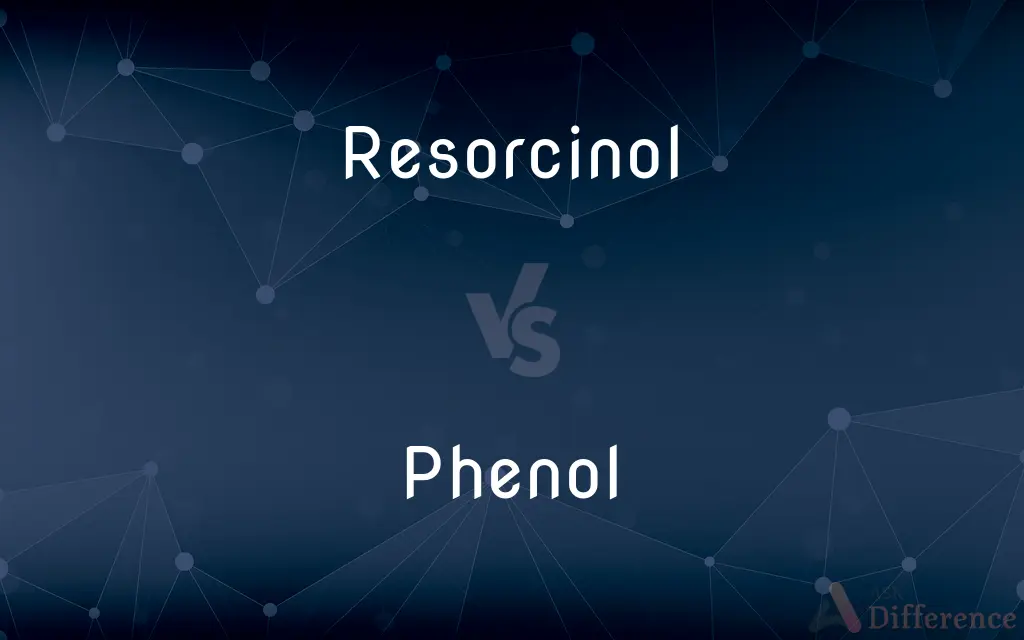Resorcinol vs. Phenol — What's the Difference?
By Fiza Rafique & Urooj Arif — Updated on April 26, 2024
Resorcinol is a dihydroxy benzene derivative used in medical and industrial applications, while phenol is a toxic aromatic compound used as an antiseptic and in chemical synthesis.

Difference Between Resorcinol and Phenol
Table of Contents
ADVERTISEMENT
Key Differences
Resorcinol is a dihydroxy benzene derivative, characterized by two hydroxyl groups attached to a benzene ring, making it more reactive and soluble in water than phenol, which has only one hydroxyl group attached to its benzene ring. This structural difference impacts their physical properties and reactivity, with resorcinol exhibiting higher solubility and reactivity in certain chemical reactions, whereas phenol, with its simpler structure, serves as a fundamental building block in organic chemistry.
In terms of applications, resorcinol is widely used in the production of resins, dyes, plastics, pharmaceuticals, and as a disinfectant in medical preparations due to its antiseptic properties. Phenol, on the other hand, is used as an antiseptic in healthcare, and extensively in the industrial synthesis of plastics and related materials. While both compounds have antiseptic properties, their different chemical properties lead to varied applications in both medical and industrial fields.
Safety and environmental concerns also distinguish these compounds. Resorcinol is considered less toxic than phenol, which is highly caustic and can cause severe burns upon contact with skin. Phenol's toxicity and environmental impact require careful handling and disposal, whereas resorcinol, despite also requiring safe handling procedures, poses less of a risk in terms of toxicity and environmental damage.
The chemical reactivity of resorcinol allows it to participate in more diverse chemical reactions compared to phenol, due to its additional hydroxyl group. This makes resorcinol a valuable component in synthesizing various chemical products, including certain types of polymers and specialty chemicals, whereas phenol's reactivity, though significant, is somewhat more limited in scope.
In medical applications, resorcinol is often found in topical treatments for acne, psoriasis, and other skin conditions due to its antiseptic and keratolytic properties. Phenol, while also possessing antiseptic properties, is used in higher concentrations for chemical peels in dermatology, highlighting their different utility and efficacy in medical treatments based on their chemical nature.
ADVERTISEMENT
Comparison Chart
Chemical Structure
Dihydroxy benzene (two hydroxyl groups attached to benzene ring)
Monohydroxy benzene (one hydroxyl group attached to benzene ring)
Solubility
More soluble in water due to additional hydroxyl group
Less soluble in water
Applications
Used in resins, dyes, plastics, pharmaceuticals, and as a disinfectant
Used as an antiseptic, in the synthesis of plastics and other materials
Toxicity
Considered less toxic than phenol
Highly toxic and caustic, can cause severe burns
Chemical Reactivity
Participates in a wide range of chemical reactions, useful in synthesizing various products
Significant reactivity, but somewhat more limited compared to resorcinol
Medical Use
Found in topical treatments for skin conditions due to antiseptic and keratolytic properties
Used in higher concentrations for chemical peels, also has antiseptic properties
Compare with Definitions
Resorcinol
A benzene derivative with two hydroxyl groups.
Resorcinol is used in various medical creams for its antiseptic properties.
Phenol
An aromatic organic compound with a single hydroxyl group.
Phenol is a crucial starting material in the production of many polymers.
Resorcinol
Used in the manufacture of resins and dyes.
Resorcinol-based resins are valued for their adhesive properties.
Phenol
Found in industrial applications and chemical synthesis.
Phenol is a precursor to many industrial chemicals and plastics.
Resorcinol
Effective in treating skin conditions.
Resorcinol is a key ingredient in treatments for acne and psoriasis.
Phenol
Highly toxic and caustic.
Due to its toxicity, phenol must be handled with extreme care.
Resorcinol
More soluble in water than phenol.
Due to its solubility, resorcinol is preferred in certain pharmaceutical formulations.
Phenol
Utilized in dermatology for chemical peels.
In dermatology, phenol is used for deep chemical peel treatments.
Resorcinol
Considered less toxic.
Resorcinol's lower toxicity makes it safer for use in consumer products.
Phenol
Used as an antiseptic in medical settings.
Phenol's antiseptic properties make it valuable for treating wounds.
Resorcinol
Resorcinol (or resorcin) is an organic compound with the formula C6H4(OH)2. It is one of three isomeric benzenediols, the 1,3-isomer (or meta-isomer).
Phenol
Phenol (also called carbolic acid) is an aromatic organic compound with the molecular formula C6H5OH. It is a white crystalline solid that is volatile. The molecule consists of a phenyl group (−C6H5) bonded to a hydroxy group (−OH).
Resorcinol
A white crystalline compound, C6H4(OH)2, with bactericidal, fungicidal, and keratolytic properties, used in the treatment of acne and other skin diseases and as a component of dyes and resin adhesives.
Phenol
A mildly acidic toxic white crystalline solid obtained from coal tar and used in chemical manufacture, and in dilute form (under the name carbolic) as a disinfectant.
Resorcinol
(organic compound) The diphenol meta-dihydroxy benzene, used as a mild antiseptic and in many industrial applications; isomeric with catechol and hydroquinone.
Phenol
A caustic, poisonous, white crystalline compound, C6H6O, derived from benzene and used in resins, plastics, and pharmaceuticals and in dilute form as a disinfectant. Also called carbolic acid.
Resorcinol
A crystalline phenol obtained from various resins; used in ointments for acne and in dandruff shampoos
Phenol
Any of a class of aromatic organic compounds having at least one hydroxyl group attached directly to the benzene ring.
Phenol
A caustic, poisonous, white crystalline compound, C6H5OH, derived from benzene and used in resins, plastics, and pharmaceuticals and in dilute form as a disinfectant and antiseptic; once called carbolic acid
Phenol
Any of a class of aromatic organic compounds having at least one hydroxyl group attached directly to the benzene ring (or other aromatic ring)
Phenol
A white or pinkish crystalline substance, C6H5OH, produced by the destructive distillation of many organic bodies, as wood, coal, etc., and obtained from the heavy oil from coal tar.
Phenol
Any one of the series of hydroxyl derivatives of which phenol proper is the type.
Phenol
Any of a class of weakly acidic organic compounds; molecule contains one or more hydroxyl groups
Phenol
A toxic white soluble crystalline acidic derivative of benzene; used in manufacturing and as a disinfectant and antiseptic; poisonous if taken internally
Common Curiosities
What is resorcinol used for?
Resorcinol is used in medical preparations as a disinfectant, and industrially in the manufacture of resins, dyes, and plastics.
Why is resorcinol more soluble in water than phenol?
Resorcinol's increased solubility is due to its two hydroxyl groups, which enhance water interaction.
Can both resorcinol and phenol be used in medical treatments?
Yes, both are used medically: resorcinol in topical treatments for skin conditions, and phenol for antiseptic purposes and chemical peels.
What distinguishes the chemical reactivity of resorcinol from phenol?
Resorcinol's additional hydroxyl group allows it to participate in a wider range of chemical reactions compared to phenol.
How are resorcinol and phenol produced?
They are synthesized through different chemical processes, often starting from benzene or other aromatic compounds.
Can phenol be found in everyday products?
Phenol is mainly used in industrial applications and certain medical treatments due to its toxicity.
Is resorcinol safe for everyday use?
While considered safer than phenol, resorcinol should still be used as directed due to potential side effects.
How does phenol's toxicity compare to resorcinol?
Phenol is more toxic and caustic than resorcinol, requiring careful handling and disposal.
What are the environmental impacts of resorcinol and phenol?
Both chemicals must be disposed of properly to avoid environmental damage, with phenol posing a greater risk due to its higher toxicity.
What is the role of phenol in plastic production?
Phenol is a precursor to many industrial chemicals and plastics, including Bakelite.
Are there natural sources of resorcinol and phenol?
Phenol can be found in natural sources like coal tar and certain organic materials, whereas resorcinol is mainly synthetic.
Can resorcinol be used in the synthesis of plastics?
Yes, resorcinol is used in synthesizing certain types of plastics and resins.
Share Your Discovery

Previous Comparison
Linguini vs. Linguine
Next Comparison
Lapilli vs. TuffAuthor Spotlight
Written by
Fiza RafiqueFiza Rafique is a skilled content writer at AskDifference.com, where she meticulously refines and enhances written pieces. Drawing from her vast editorial expertise, Fiza ensures clarity, accuracy, and precision in every article. Passionate about language, she continually seeks to elevate the quality of content for readers worldwide.
Co-written by
Urooj ArifUrooj is a skilled content writer at Ask Difference, known for her exceptional ability to simplify complex topics into engaging and informative content. With a passion for research and a flair for clear, concise writing, she consistently delivers articles that resonate with our diverse audience.
















































